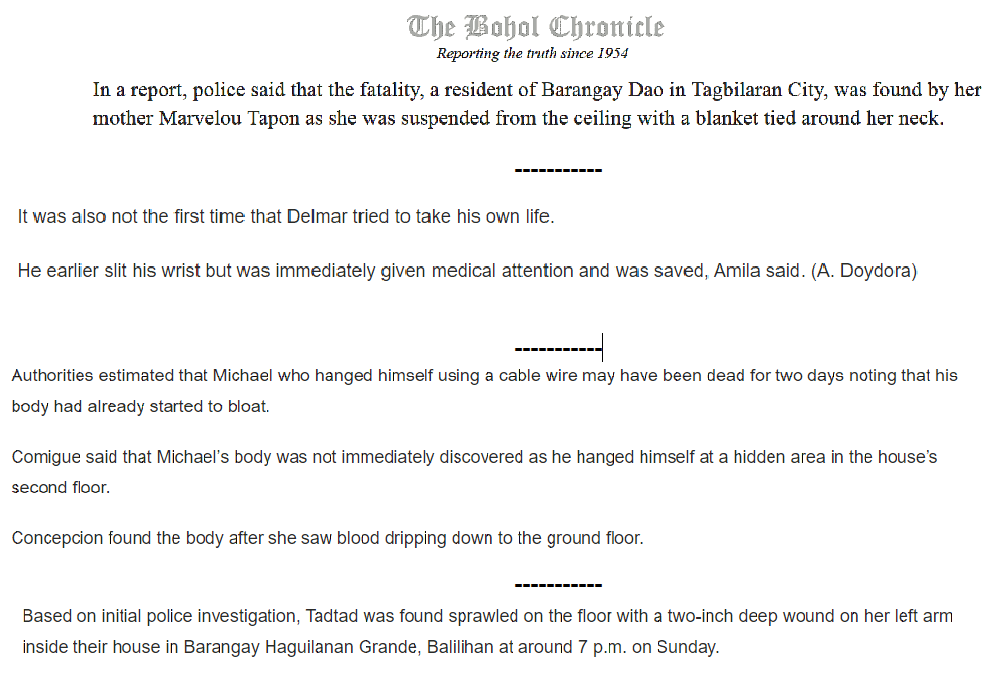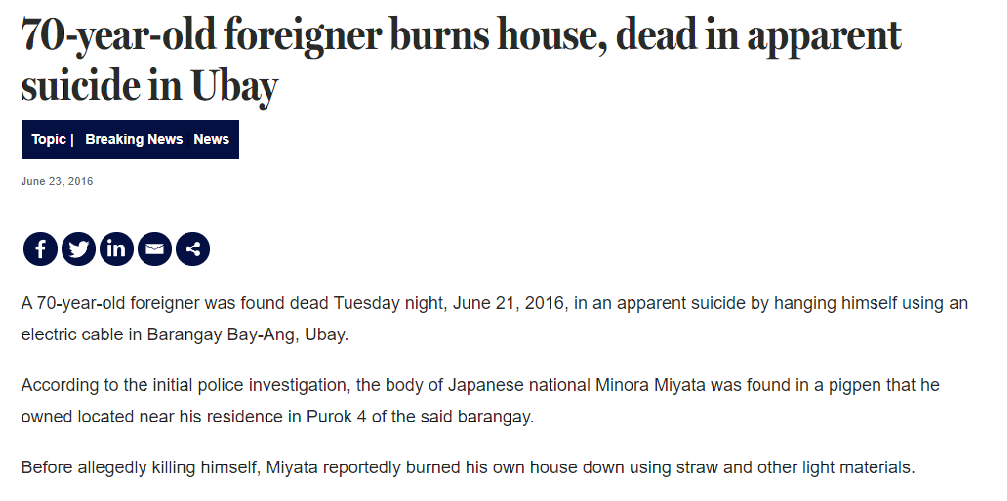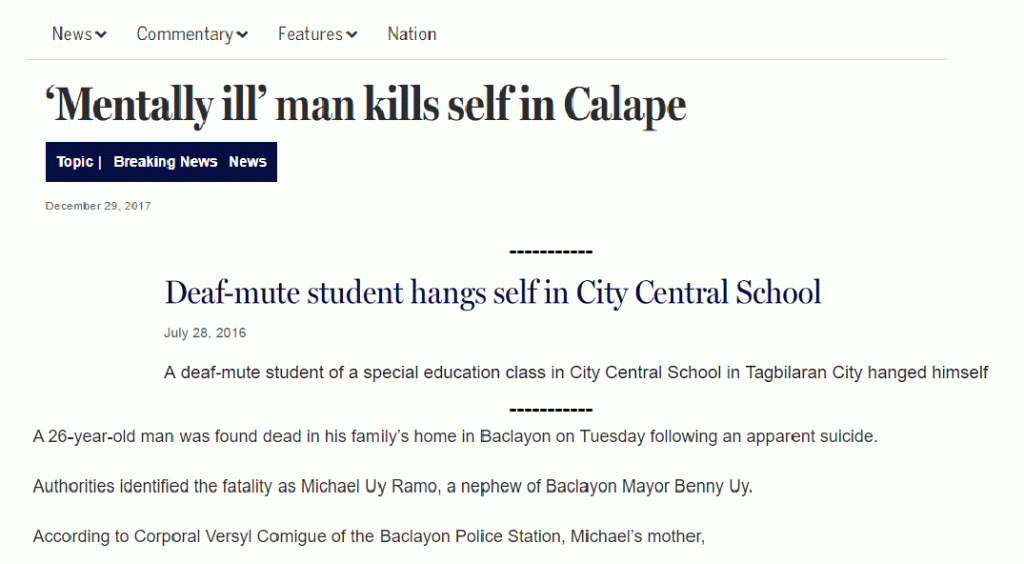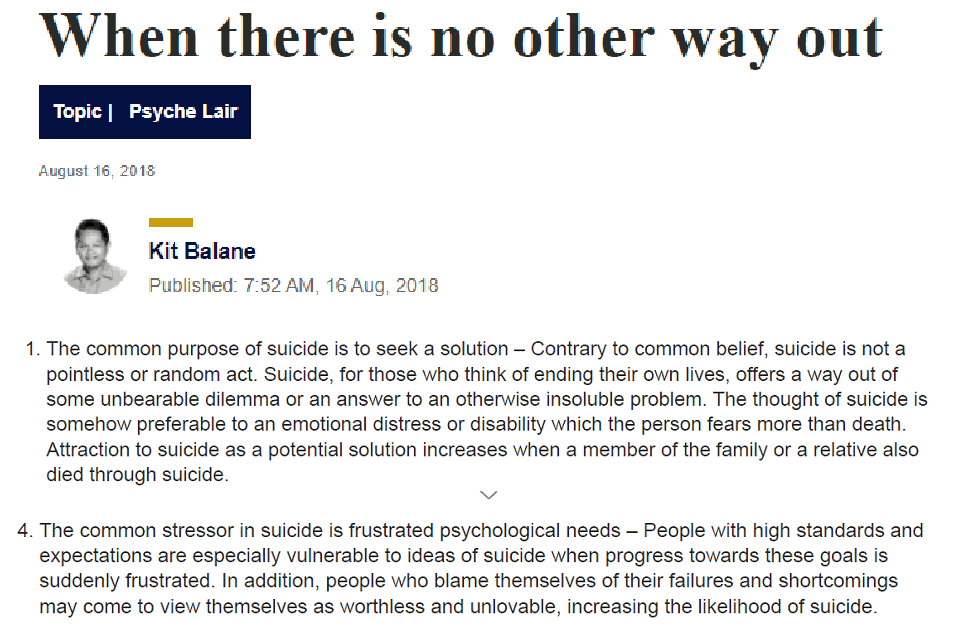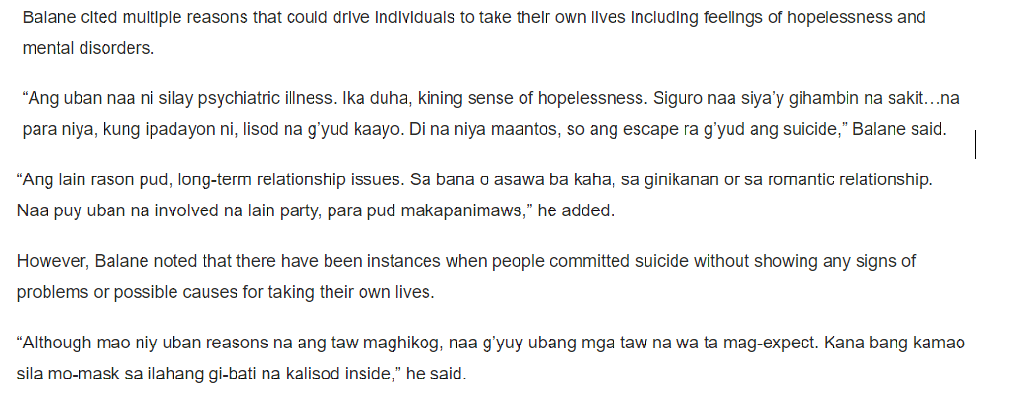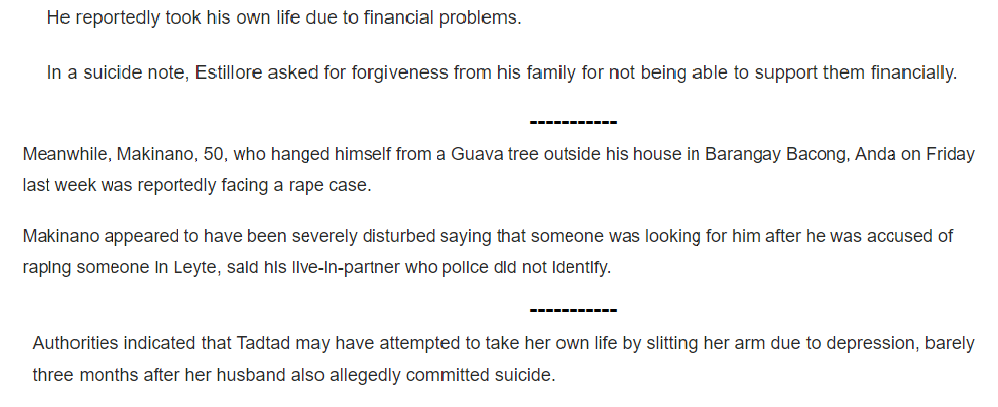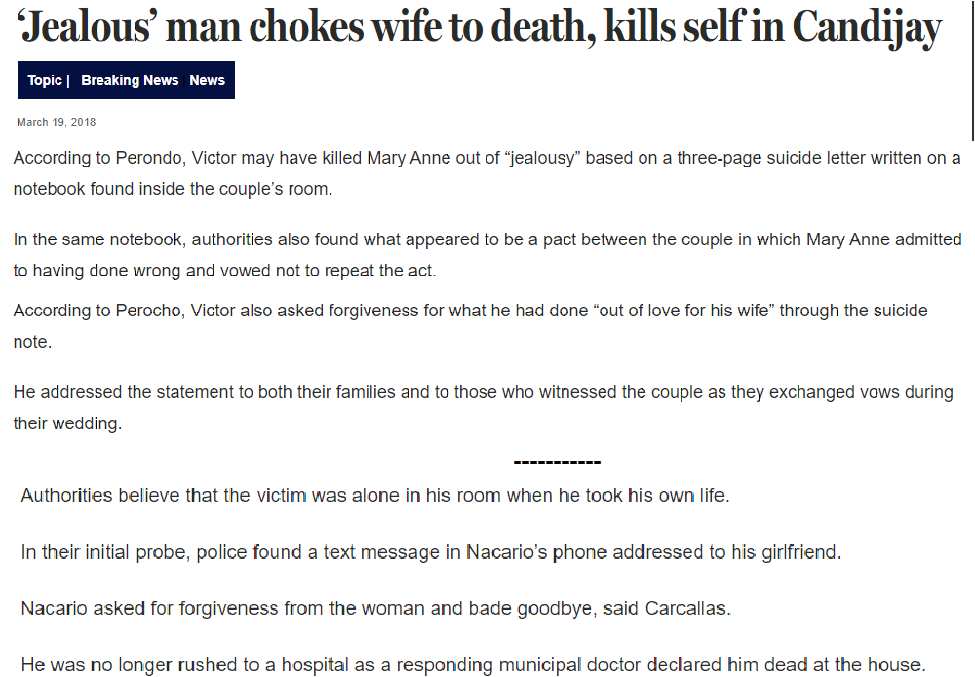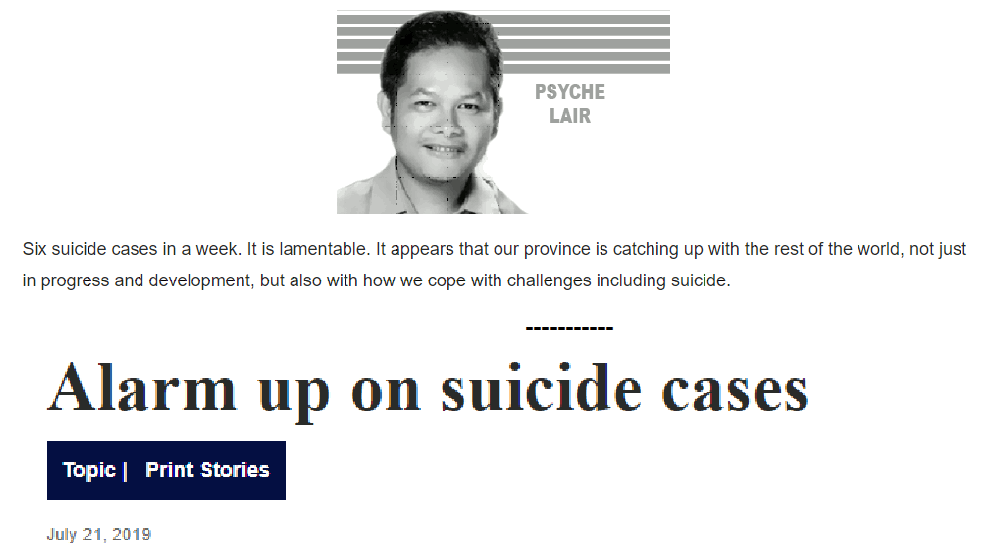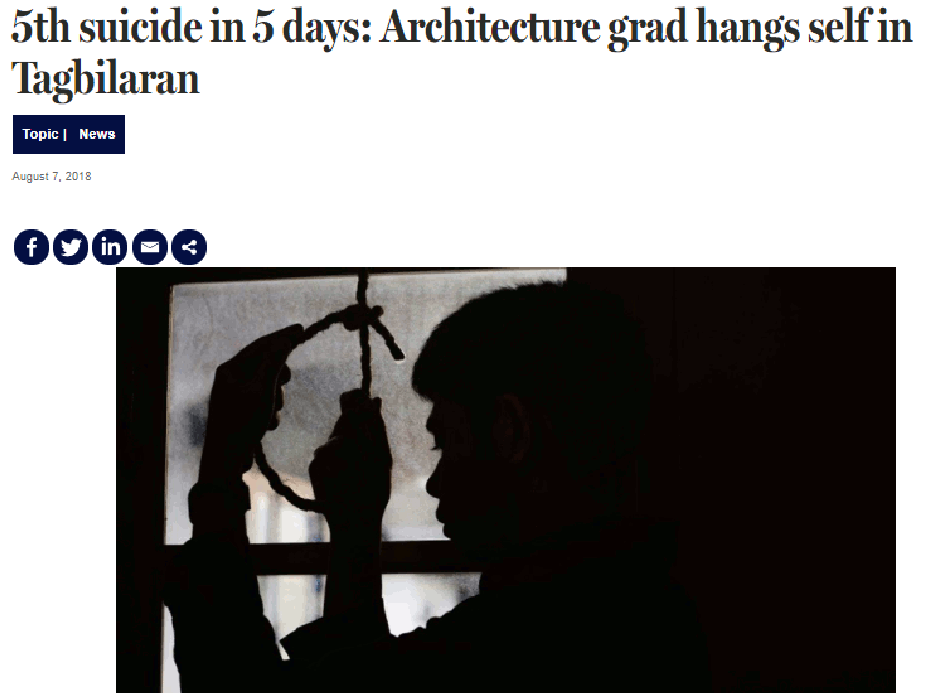Don’t do it. There is a better way. I promise you, in the name of Jesus Christ, there is a better way. You don’t feel that, perhaps, right now, but your feelings are not true. They are deceiving you. It is true that God has another way for you. He always makes another way.
John Piper, in Suicide and Salvation, 2014
Zoilo “Bingo” P. Dejaresco III
Editor, Bohol Chronicle
Tagbilaran City, Bohol
Kit N. Balane
Psychologist, Columnist, Bohol Chronicle
Tagbilaran City, Bohol
October 13, 2021
Greetings, gentlemen:
In 2018 and 2019, I started writing to Bohol Chronicle via their social media presence about some very disturbing depictions of suicide in their news reports.
I am writing again, with the hope that the Bohol Chronicle will consider suicide reporting as a uniquely difficult but important task. Thus, my intention in this letter is not to limit press freedom, but rather, to encourage safe yet effective suicide reporting, in line with public health standards.
Why is suicide reporting a particularly different kind of news reporting? Numerous studies have shown that suicide reporting, when done inappropriately, inadvertently increase this public health risk.
Exposure to suicide through media may make people more likely to resort to suicidal behaviors themselves. When a story about suicide is posted, it may captivate individuals in crisis who identify with the story. This is known as “suicide contagion.” Over 100 studies worldwide have found that the risk of contagion is real. Research also indicates that duration, frequency, and prominence of suicide news reports are the most influential factors that increase risk of suicide contagion.
The reporting of suicide, unlike other news coverage practices, is not “Breaking News.” Also, suicide is not a crime and therefore should not be portrayed as such. Suicide is a public health problem that can be prevented.
Covering suicide carefully can change perceptions, dispel myths and inform the public on the complexities of the issue. Media reports can result in help-seeking when they include helpful resources and messages of hope and recovery.
Please consider the following recommendations.(1) The goal is to reduce suicide contagion:
Instead of describing or depicting the method and location of the suicide, best practice is to report the death as a suicide; keep information about the location general.
Instead of sharing the content of a suicide note, report that a note was found and is under review.
Instead of describing personal details about the person who died, keep information about the person general.
Instead of presenting suicide as a common or acceptable response to hardship, report that coping skills, support, and treatment work for most people who have thoughts about suicide.
Instead of oversimplifying or speculating on the reason for the suicide: avoid oversimplified, dramatic headlines. Suicide is complex. Be sure to avoid single cause explanations. Certain events or factors can precipitate a suicide, but there are almost always multiple underlying causes. Best practice is to describe suicide warning signs and risk factors that give context to the suicide. Please understand that “risk factors” are not the same as “reasons.” Major risk factors include prior suicide attempt(s), mood disorders, substance abuse, and access to lethal means. Major protective factors include effective mental health care, connectedness, problem-solving skills, and contacts with caregivers. It is best to provide more information on protective factors and not speculate any reasons for suicide.
Instead of sensationalizing details in the headline or story, report on the death using facts and language that are sensitive to a grieving family. The Chronicle is not a tabloid and as it partners with the PDI to keep up-to-date with higher standards of journalism, including civic journalism, it should set the example for other media on the island.
Instead of glamorizing or romanticizing suicide, just provide context and facts to counter perceptions that the suicide was tied to heroism, honor, or loyalty to an individual or group.
Instead of overstating the problem of suicide by using descriptors like “epidemic” or “skyrocketing”, simply state available data.
Instead of prominent placement of stories (Chronicle often places suicides in “Breaking News”) related to a suicide death in print or on the web, place the article inside the paper or website (not on the website homepage). If images are used, choose images that show the individual who died by suicide engaging in life rather than clutching a noose like what the Bohol Chronicle use in their website.
Below, are some examples from the Chronicle coverage of suicide, collected from the Chronicle website just this week. This means, as of October 13, 2021, the suicide reports are still accessible to the public. I highlight the specific areas where the reports do not follow good suicide reporting guidelines.
Avoid prominent placement of stories related to a suicide death in print or in newscast. Suicide is not “Breaking News”

With all of the above, may I please request:
- That the suicide news reports on the Bohol Chronicle Website, including the headlines and the disturbing image of the boy with a noose, be edited to reflect best practices and recommendations on responsible suicide reporting; while it is probably easier to remove the news reports from the website, I think it would be a much better exercise for the reporters and editors to edit the suicide news reports themselves as implementation of best practices; and
- That the comments by Kit N Balane and his August 16, 2018 column about suicide, “When there is no other way out” be removed or edited. The column is particularly dangerous because it lists the various reasons why someone may take their own life “when there is no other way out.”
What Balane has inadvertently done is enumerate the “common purpose” of suicide: (“common emotion in suicide is hopelessness-helplessness”, “common stressor in suicide is frustrated psychological needs”, “common stimulus in suicide is intolerable psychological pain”, “common purpose of suicide is to seek a solution”, “People with high standards and expectations are especially vulnerable to ideas of suicide” etc.). He made a menu of traits which someone may connect with in relation to the contemplation of suicide. According to Dr. Ayal Schaffer, a psychiatry professor at the University of Toronto and a co-author of study on media and suicide contagion, “The more someone is able, in a very specific way, to get connected to this story — and if they can see themselves in that person or wanting to be that person or admiring that person — that story becomes a very powerful driver to their behavior.” (2)
The articles appearing on the Chronicle website are particularly important, more so than in print because more people, especially the youth, get their news from social media sources, where stories are much easier to “share” or “retweet” and archive material from many years back remain easily accessible to anyone on the internet. Online content remains accessible on the internet indefinitely, therefore its potential to contribute to suicide contagion increases over time.
To support your editorial team and reporters, I attach to this letter the PDF document “Suicide Reporting Recommendations, Media As Partners in Suicide Prevention” by the American Association of Suicidology in conjunction with their state mental health and addiction services and school of journalism.(3)
I sincerely hope that with this letter, the Bohol Chronicle can increase compassion, promote awareness of coping tools, and provide pathways to recovery in this current public health concern. We can change public perceptions by telling stories about real people who struggle with suicide yet find meaning and value in life despite these struggles. Wouldn’t that be a more noble and beautiful act of journalism?
With sincere best wishes,
Fatima Lasay
San Roque, Baclayon, Bohol
(1) Based on www.ReportingonSuicide.org/Recommendations
(2) How Should the Media Cover Suicides? A New Study Has Some Answers
(3) www.Suicidology.org
OTHER RESOURCES:
Why Suicide Reporting Guidelines Matter
Influences of the Media on Suicide
The Role of Media in Suicide and Self-harm

